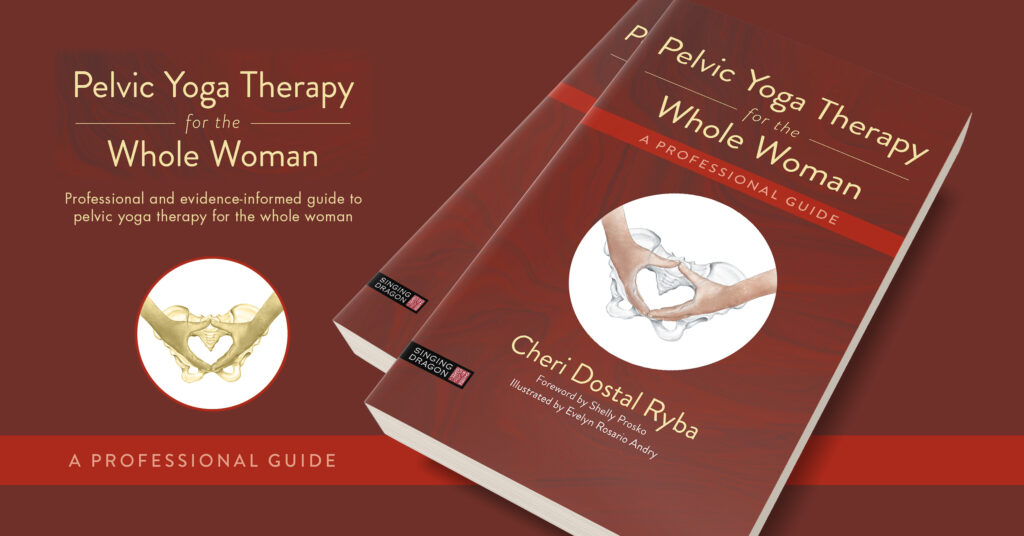by Cheri Dostal Ryba, C-IAYT

I suspect by now many of us have heard that kegels may exacerbate symptoms for some people, and can have limited benefit for others. Pelvic health, like any health or fitness pursuit, requires a dynamic, whole body and whole person approach to creating a lifestyle that both minimizes symptoms and supports healing and thriving. No ‘correct posture’, ‘best’ exercise, or one cookie cutter approach can possibly meet the varied demands of daily life, our psychoemotional fluctuations, and the ever-evolving needs at different seasons in a woman’s cycle and lifespan. Yoga therapy represents a customized, integrative, and collaborative approach to healthcare and wellbeing that respects the complexity of the individual.
Pelvic yoga therapy, put simply, utilizes this comprehensive, therapeutic approach to yoga to improve someone’s pelvic embodiment and function.
The pelvic tissues ideally demonstrate a beautiful, reflexive coordination, oscillating with each breath and in response to movement, load and impact. Our root level security, receptivity and safety, illustrated by themes related to the muladhara chakra, as well as from a nervous system informed perspective, play out tangibly here in the pelvis. We cannot separate the physical symptoms, conditions, function or pleasure from the other layers of one’s experience, identity and history.
The therapeutic relationship centered in this modality builds rapport and offers containment that supports the honest reflection and unraveling of long held beliefs, habits, and encourages integration. Pelvic yoga therapy welcomes the totality and range of experiences held in one’s pelvic bowl and presents the possibility for creation, expression, function and vitality to be restored.
Yoga begins with ethical and self-reflection principles, then moves through the other limbs of practice that include asana, pranayama, concentration and more. Physical postures of yoga parallel mechanical, conventional exercise – often beneficial when done regularly, and eventually (hopefully) this regular physical practice opens the door to the breadth and depth of transformation available to us from exploring the full yogic path.
Clinicians frequently integrate mindbody practices like yoga, using postures, breath awareness, and guided meditation and relaxation in treatment plans. While this provides the patient with a useful home practice and ways to tend to their own needs with yoga, it may be designed and packaged devoid of the distinct philosophical and methodological foundations of this rich tradition. I welcome all yoga teachers, healthcare providers and movement professionals to consider completing training in yoga therapy applications and yoga philosophy before implementing the techniques of yoga therapeutically.
I’ll briefly share a few distinctions that differentiate yoga therapy from private yoga and clinical, licensed pelvic healthcare.
The transmission of yoga through embodiment
As an oral tradition and a system of studying and experiencing a state of yoga, embodiment is at the forefront of yoga therapy. While we may utilize both ‘top-down’ cognitive and mental strategies alongside ‘bottom-up’ tools like the postures and breathwork practices, we ultimately experience all of life through the vessel and senses of our physical body. Yoga is a sensual, somatic practice that expands and anchors consciousness. Yoga therapists commit to being practitioners alongside their professional role. Our own nervous system regulation, movement efficiency, pelvic embodiment, unshaming and unlearning of cultural stigmas, sexual liberation and more all feed into the way we show up to meet a pelvic yoga therapy client. The more whole, intact, and resilient we are personally, the better we can share and express the state of wholeness and harmony that is yoga. Experiential, somatic practice and movement training, practicing nonjudgmental awareness, clear boundaries and informed consent, and cultivating personal capacity elevates the quality of care we provide to others, not to mention it sustains us and our career, too.
Seeing and assessing the whole woman
As yoga therapists focusing on pelvic health outcomes, we seek to understand commonalities and patterns in pelvic health conditions and the desired baseline anatomical function of the pelvic floor, yet this intellectual knowledge falls short if we fail to see the person in front of us as whole, complex, and sovereign.
Yoga, at its ancient roots, understood and established what we’ve come to know in contemporary times as a biopsychosocial-spiritual (BPSS) model of care. The panchamaya model, known as the five koshas or layers of human existence, comes from the Vedic text of the Taittriya Upanishad. Through this lens, a yoga therapist identifies what signifies health and the presenting imbalances that impede wellbeing on each of the five levels: physical, physiological, mental-emotional, social-relational, and spiritual.
With physical assessment and movement function, we use this approach to observe global relationships across the whole body and how they might be influencing the pelvic floor’s function. Instead of teaching them a dogmatic ‘right way’ to do a posture, we first practice observing accurately. How do they move in and out of the posture? What happens when they hold a position? What do they report as sensation or effort?
This process of dialogue illuminates and respects the student’s perceptions, and can help them track what they feel as well as when something changes in how they feel. When we observe an alignment or recruitment imbalance, we can become curious scientists, investigating together with our students to find incremental improvements during and as a lasting result of the physical practice. Through this formal assessment process, we further differentiate the personalized power of yoga therapy from teaching yoga as a more generalized practice.
Yoga believes we are wholly well in essence. The yoga therapist will select and apply practices and principles that aim to reduce the accumulated obstacles, waste, suffering and stagnation that prevent this innate intelligence and expression from flowing freely. We offer observations with compassion and as an invitation for students to employ self-awareness and find meaning within, not despite, their existing lived experience. By approaching one’s pelvic symptoms, pain, or frustration with empathy and clarity, they can begin to act on their own behalf in a more skillful, comprehensive way to produce positive changes.
Facilitating self-efficacy
Any healing professional, I hope, understands the ethical obligation to put the power of transformation squarely in the student’s hands. We cannot do this work for them. Yoga therapy is not a passive therapeutic modality, it requires active participation. We facilitate and guide the experience, ultimately witnessing people in their evolution, integration and embodiment of their goals through the process of yoga therapy.
Corrective practices need to take root as embodied functioning. Over time the yoga therapy practice instills a ‘new normal’ for how we approach and perform daily tasks, exercise, posture, toileting, sexuality and more. The ability to meet one’s experience with kindness, discern next best steps – and take them, grows with increasing levels of self-efficacy and confidence developed through consistent practices like yoga and yoga therapy.
Entering a new era
Yoga therapists and internal pelvic floor specialists can work side by side to improve outcomes for individuals with pelvic conditions and concerns. I recommend inquiring at local clinics, hospitals, birthing centers, and yoga studios to find and vet providers in your area and build a robust referral network to support your community. We can garner new insights and bolster our professional efficacy by working together, and these collaborative relationships can continue driving systemic change and improve access to pelvic care for all.
More than ever, people are talking openly about their pelvic conditions, seeking help for their symptoms, rewriting the scripts of motherhood and menopause, and reclaiming the identity of survivor.
I feel proud to contribute to the quality of women’s health and healthcare and look forward to the day where we fully embrace the revolution we’re planting now. May this article, this book, and every student and women’s circle it supports lead us to embodied liberation.
Cheri Dostal Ryba, C-IAYT is a yoga therapist and Franklin Method Movement Educator with 20 years experience in teaching yoga, dance, corrective exercise and personal training. Mentoring yoga teachers since 2010, she currently serves as co-director and faculty of AlcheMe Yoga Therapy Training based in Irvine, CA and online. In 2018, she launched an online program for foundational pelvic health embodiment. She lives in California with her family and serves clients online globally. To enroll in training, online programs, or work together, visit www.cheridostal.com.
To purchase a copy of Pelvic Yoga Therapy for the Whole Woman: A Professional Guide click here.
